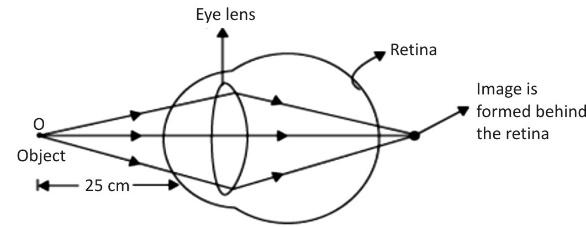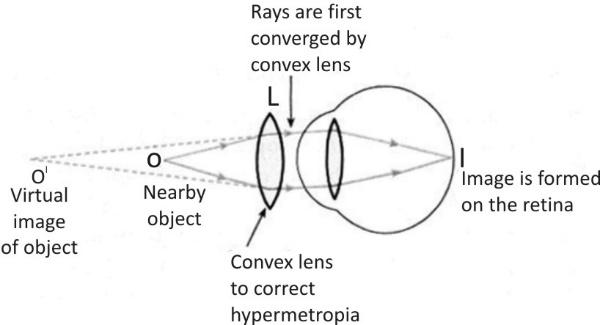
Draw a diagram to show how hypermetropia is corrected.
Answer
480.3k+ views
Hint:Hypermetropia i.e. long-sightedness is a common eye condition where nearby objects/bodies appear blurred, but the vision is clearer when you are looking at things far away. Simply, we can say that Hypermetropia is a defect of vision caused by an imperfection in the eye. When the eyeball is too short or the lens cannot become round enough, causing the eye to not have enough power to see close or nearby objects. This defect is usually genetic and can be corrected by using a convex lens. It can occur at any age but becomes noticeable above forty years. Now again, Hypermetropia or long sightedness a person is not able to see nearby objects clearly. The near point shifts away from $D = 25cm.$
Causes: 1. The contraction in the size of the eyeball i.e. distance of retina from eye lens has decreased.
2. The focal length of the eye lens has increased.
Complete step by step answer:
Hypermetropia (long-sightedness) is a defect of an eye where a person cannot see nearby objects clearly. The near point of Hypermetropia eye is more than $D = 25cm$ away. This defect of eye is caused due to, non-converging power of eye-lens, eyeball being too short, in this case the image of an object is formed behind the retina and therefore, a person cannot see nearby objects.The ray diagram of Hypermetropic eye, the image of a nearby object (object is at minimum distance of vision i.e. at $D = 25cm$) is formed behind the retina.

The near-point of an eye having Hypermetropia may be equal to or more than $D = 25cm.$ Now, the condition of Hypermetropia can be corrected by putting a convex lens in front of the eye. This is because when a convex lens of suitable power is placed in front of the hypermetropic eye, then the convex lens first converges the diverging rays of light coming from a nearby object at the near point of the eye at which the virtual image of the nearby object is formed. Now, since the light rays appear to be coming from the eye’s near point, the eye-lens can be easily focused and form the image on the retina convex lens that is used for Hypermetropia so as to increase the converging power of the eye-lens.

The convex lens forms a virtual image of the object ${O^l}$which is lying at normal near point $\left( {D = 25cm} \right)$ at The lens formula is, $\dfrac{1}{v} - \dfrac{1}{u} = \dfrac{1}{f},$ here u is normal near point $D = 25cm$ where the object is placed. Here f is the focal length of the lens suggested to a person in hypermetropia and v is the position of image formed here at ${O^l}.$
Note:The minimum value of near point is of $D = 25cm$, it may be greater than $D = 25cm,$ depends upon the eye of the hypermetropic person.
Causes: 1. The contraction in the size of the eyeball i.e. distance of retina from eye lens has decreased.
2. The focal length of the eye lens has increased.
Complete step by step answer:
Hypermetropia (long-sightedness) is a defect of an eye where a person cannot see nearby objects clearly. The near point of Hypermetropia eye is more than $D = 25cm$ away. This defect of eye is caused due to, non-converging power of eye-lens, eyeball being too short, in this case the image of an object is formed behind the retina and therefore, a person cannot see nearby objects.The ray diagram of Hypermetropic eye, the image of a nearby object (object is at minimum distance of vision i.e. at $D = 25cm$) is formed behind the retina.

The near-point of an eye having Hypermetropia may be equal to or more than $D = 25cm.$ Now, the condition of Hypermetropia can be corrected by putting a convex lens in front of the eye. This is because when a convex lens of suitable power is placed in front of the hypermetropic eye, then the convex lens first converges the diverging rays of light coming from a nearby object at the near point of the eye at which the virtual image of the nearby object is formed. Now, since the light rays appear to be coming from the eye’s near point, the eye-lens can be easily focused and form the image on the retina convex lens that is used for Hypermetropia so as to increase the converging power of the eye-lens.

The convex lens forms a virtual image of the object ${O^l}$which is lying at normal near point $\left( {D = 25cm} \right)$ at The lens formula is, $\dfrac{1}{v} - \dfrac{1}{u} = \dfrac{1}{f},$ here u is normal near point $D = 25cm$ where the object is placed. Here f is the focal length of the lens suggested to a person in hypermetropia and v is the position of image formed here at ${O^l}.$
Note:The minimum value of near point is of $D = 25cm$, it may be greater than $D = 25cm,$ depends upon the eye of the hypermetropic person.
Recently Updated Pages
Master Class 11 Accountancy: Engaging Questions & Answers for Success

Express the following as a fraction and simplify a class 7 maths CBSE

The length and width of a rectangle are in ratio of class 7 maths CBSE

The ratio of the income to the expenditure of a family class 7 maths CBSE

How do you write 025 million in scientific notatio class 7 maths CBSE

How do you convert 295 meters per second to kilometers class 7 maths CBSE

Trending doubts
Compare the advantages and disadvantages of multipurpose class 10 social science CBSE

What are five examples of facts and opinions class 10 english CBSE

Which state has the longest coastline in India A Tamil class 10 social science CBSE

What is the subject of a story and what is the the class 10 english CBSE

What is the difference between anaerobic aerobic respiration class 10 biology CBSE

What is the full form of POSCO class 10 social science CBSE




